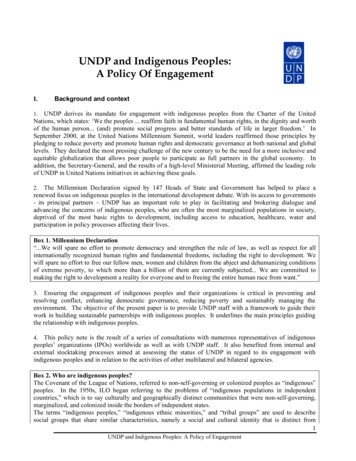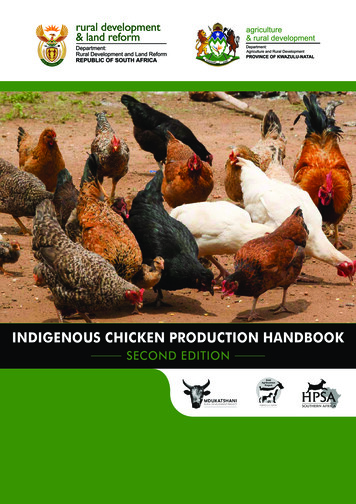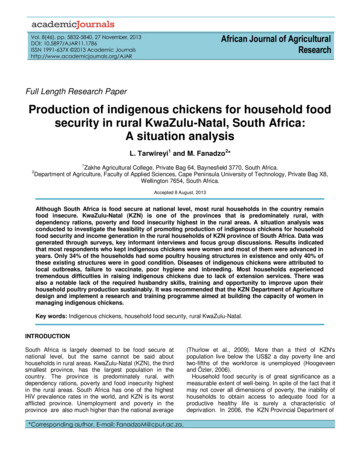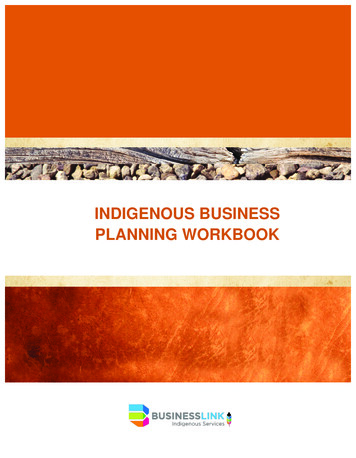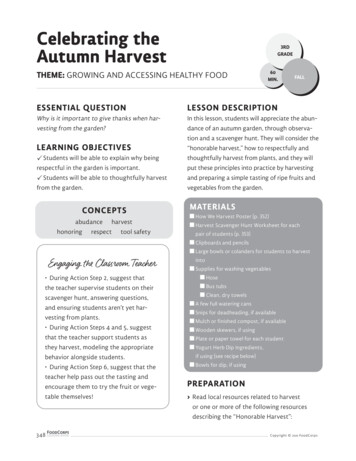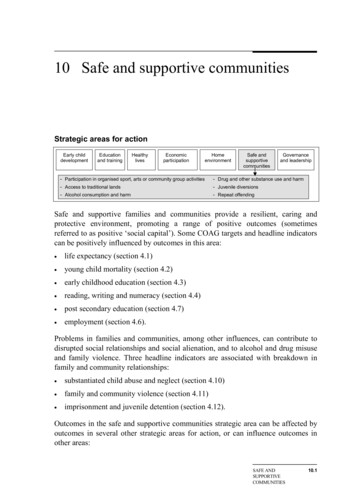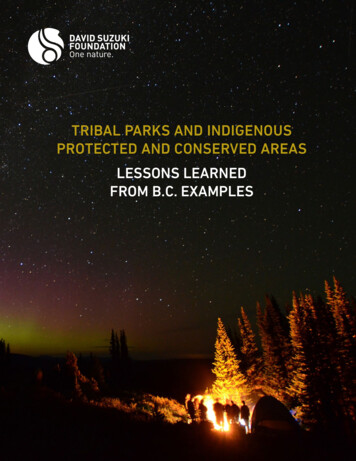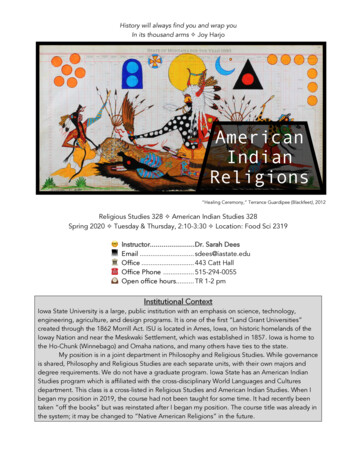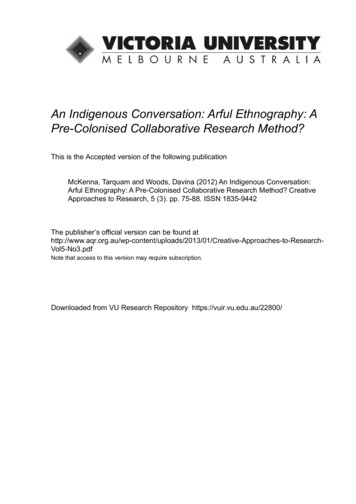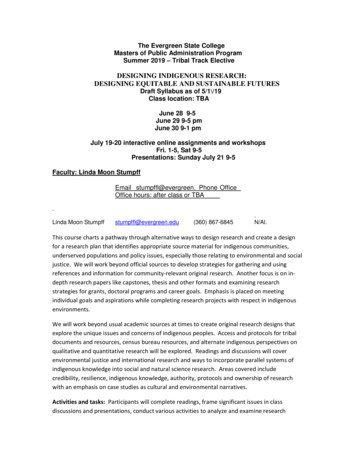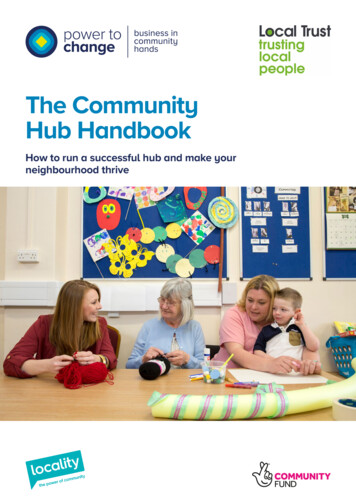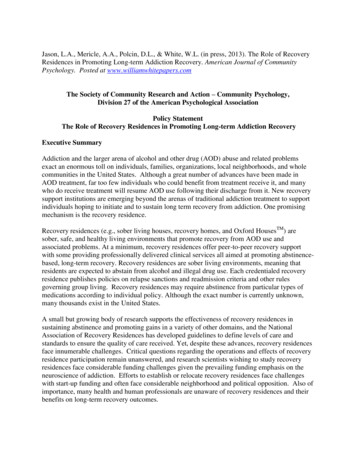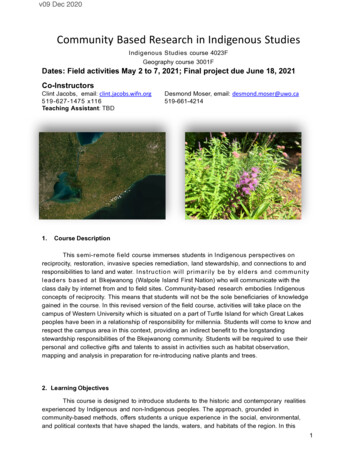
Transcription
v09 Dec 2020Community Based Research in Indigenous StudiesIndigenous Studies course 4023FGeography course 3001FDates: Field activities May 2 to 7, 2021; Final project due June 18, 2021Co-InstructorsClint Jacobs, email: clint.jacobs.wifn.org519-627-1475 x116Teaching Assistant: TBD1.Desmond Moser, email: desmond.moser@uwo.ca519-661-4214Course DescriptionThis semi-remote field course immerses students in Indigenous perspectives onreciprocity, restoration, invasive species remediation, land stewardship, and connections to andresponsibilities to land and water. Instruction will primarily be by elders and communityl e a d e r s b a s e d a t Bkejwanong (Walpole Island First Nation) who will communicate with theclass daily by internet from and to field sites. Community-based research embodies Indigenousconcepts of reciprocity. This means that students will not be the sole beneficiaries of knowledgegained in the course. In this revised version of the field course, activities will take place on thecampus of Western University which is situated on a part of Turtle Island for which Great Lakespeoples have been in a relationship of responsibility for millennia. Students will come to know andrespect the campus area in this context, providing an indirect benefit to the longstandingstewardship responsibilities of the Bkejwanong community. Students will be required to use theirpersonal and collective gifts and talents to assist in activities such as habitat observation,mapping and analysis in preparation for re-introducing native plants and trees.2. Learning ObjectivesThis course is designed to introduce students to the historic and contemporary realitiesexperienced by Indigenous and non-Indigenous peoples. The approach, grounded incommunity-based methods, offers students a unique experience in the social, environmental,and political contexts that have shaped the lands, waters, and habitats of the region. In this1
v09 Dec 2020course, students will be exposed to complex social and environmental histories and situations,all with the broad goals of enhancing their overall understanding of: decolonization and indigenization in a campus contextIndigenous approaches to land stewardshiphistorical and contemporary interactions between people and diverse ecologiesbecome familiar with indigenous vegetation types and their significancethe ways in which Indigenous and non-Indigenous peoples can work together towardcommon objectives geographic field approaches to mapping and analysis3. Course FeesThe fee for this course is 250 payable to the respective undergraduate coordinators inIndigenous Studies and Geography. The fees go toward remote connectivity hardware oncampus, a copy of the course book (“Braiding Sweetgrass” by Robin Wall Kimmerer) and tosupport an end-of course feast. Students are eligible to apply for reimbursement from theuniversity.4. BackgroundBkejwanong, which in English means “Where the Waters Divide,” is home to theAnishinaabe p e o p l e of Walpole Island First Nation. Their current community is situated on sixislands in the St. Clair River Delta, the largest freshwater delta in North America. The traditionalhomeland territory of Bkejwanong extends beyond the islands to Lake Huron, the Detroit River,Lake Erie, Michigan and Southern Ontario.Despite centuries of colonization, the Anishinaabeg still consider the traditional territorytheir home, and as such they have inherent rights when it comes to the development of landand waters both on the delta, often referred to as the “Reserve” and in their traditional territory.Over the past two centuries, these rights have often been ignored, or worse, attempts havebeen made to remove these rights by the Canadian government, non-indigenous industries andsettler society.During this me the pre-seAlement land cover of Western University campus has been reducedto small groves of selected Carolinian trees, and isolated copses, maintained as part of the SherwoodFox Arboretum, interspersed are small patches of prairie and an Indigenous teaching garden. Along thewaters of the Deshkan Ziibi (“Antler R i v e r ” ) , r e n a m e d T h a m e s R i v e r i n 1 7 9 3 , a r e stretchesof mixed indigenous and invasive riparian plants and trees. East campus includes the junction of theDeshkan Ziibi with the Medway Creek tributary which drains a remarkably biodiverse area of rareplants and freshwater mussels within the City of London. First Nations dwellings along the MedwayCreek date back 1000’s of years. While much of Walpole Island remains biologically diverse, it toofaces pressures from development and degradation. Nevertheless, it stands out as a biodiversitygiant among the intensely farmed Carolinian zone and is home to one of the largest contiguoustracts of forests in southwestern Ontario, globally imperilled oak savannah and tallgrass prairieremnants, one of the largest wetlands in the Great Lakes basin, and rich coastal waterways.These habitats support more than 70 species at risk.Successive generations of agricultural, industrial, and town planning have not includedIndigenous presence and land-use planning and practices, while often disregarding anddegrading bioregional ecosystems. As a result, one of the current challenges facing both the2
v09 Dec 2020Indigenous and surrounding non-Indigenous communities is to maintain and restore theremnant and marginal Carolinian forest, oak savannah, tallgrass prairie, riparian, and aquaticecosystems. Such restoration efforts and care of existing remnant habitats are understood tobe key to Indigenous cultural survival. While there are no easy solutions to the environmentalchallenges, in the area occupied by the UWO education about decolonizing the planningprocess in line with Indigenous-centered approaches is an important goal in this course.5. Cultural AwarenessStudents are expected to have a basic understanding and respect of Anishinaabeg cultureand the Carolinian ecozone as well as shared approaches of other First Nations in southernOntario. Peoples of the Haudenosaunee and EELÜNAAPÉEWI LAHKÉEWIIT (Delaware) culturesare also close to London, mostly downriver from the Western University campus. Appropriateethical and cultural respect will be expected of all students throughout the duration of the course.Students are not expected to be cultural experts, and relevant cultural understandings will beshared with the students as part of the learning process. Specifically, the concept of reciprocityas it relates to the ‘host’ Anishinaabeg c o m m u n i t y a t B k e j w a n o n g will be used as apedagogical tool before, during, and after our community-guided experience.6. PreparationStudents will receive an orientation and logistical meeting prior to the field course. At thistime students will be given the course text book which we will read together in four stages beforeMay 2, 2021. Any additional readings will be posted on OWL. Students are expected to bring thefollowing items: a smart phone or tablet capable of wireless reception (details TBD) and photography (a fewunits will be made available for signout as necessary) Personal medication, notification of potential health related issues, allergies, sensitivities,and emergency contact information / health card. Personal Protective Equipment (PPE) such as face masks, hand sanitizer, etc. Hat, water bottle, work gloves, hiking shoes, rain gear, rubber boots, safetyglasses, sunscreen, etc.Clipboard, Notepad, waterproof paper, pens or pencils, and a camera (cellphone). 3
v09 Dec 20207. AssessmentTwo, pre-fieldwork assignments25%Assignment 1 (20%):Students will submit four, one-page reflections following each of four zoom discussion sessions (onein each of Jan, Feb, March and April) of the course textbook “Braiding Sweetgrass”.Assignment 2 (5%):This assignment is designed to acquaint students with the geography, culture, ecology, andhistory of this part of Turtle Island. At the pre-field course meeting, students will have theopportunity to choose one of three topics: route map assignment, settlement assignment, andnations assignment. This assignment is due when we meet for our first class. For the route map assignment, students can use google earth to plot the road, trail, andriver routes between the north end of Walpole Island (Highbanks), a n d WesternUniversity. Chart the distance it takes to travel to each location by canoe, foot andautomobile. For the settlement assignment, students are asked to document the history ofland occupancy and use of the UWO campus and Medway Creek areas sincethe last glaciation. The Nations assignment will require students to identify each of the Indigenous l a n d sa n d nations currently within a 150km radius (i.e. distance to Walpole Island) of theWestern University campus, the treaties to which they were signatory in the lower GreatLakes, at least one of the signatory Chiefs, and the extent of the traditional territory.Personal Reflections25%Each night students will reflect on the day’s activities and record, on loose-leaf paper or ajournal, their thoughts, questions, and insights into what they’ve learned. At the end of eachday, students will be given a question to answer relating to course material and dailyencounters.Individual Project45%During the week students will identify a project that is realizable by the end of June, with mostfield work completed during the first week of May. This project will be developed in consultationwith the instructors. The project must fall within the scope of the course philosophy andcommunity needs identified by members of the Heritage Centre, and must focus on some aspectof restoration or cultural protocol, with an ethic of reciprocity. If the project is a paper, the topicand focus of the paper will be determined in conversation with the instructors. Project examples:vegetation and soil observation, identification and mapping, tree planting, care and weeding, watermonitoring, educational treaty resources, and documentation.Photographic Portfolio5%This assignment involves preparation of a digital folder or PowerPoint-type file with up to ten(10) pictures taken by you on the field course with a digital camera. Pictures can be of nature,culture, people, adventure, geography, etc. and are to be delivered in full resolution with a brieftitle and caption to the OWL dropbox, by Friday May 21, 2021 (two weeks after the field work). Theup-to-10 pictures per person will be shown to the whole group at a post-fieldwork gathering.4
v09 Dec 20208. Location InformationThis is a semi-remote field course guided by elders and knowledge holders from Walpole IslandFirstNation. The activities will be on the Western University campus (See Figure 1 for potential locations) ,centered on an outdoor location with secure wifi signal and access to a sheltered space in case ofinclement weather. Students should expect to be out of doors for the full day and ready to start firstthing in the morning.Course TextRobin Wall Kimmerer. Braiding Sweetgrass. Milkweed Press, 2013.SECTION ON CULTURAL RESPECT, BASIC RULES, COVID PROTOCOLS, CODES OFCONDUCT, ETC. [TO BE UPDATED in WINTER TERM]5
campus, a copy of the course book ("Braiding Sweetgrass" by Robin Wall Kimmerer) and to support an end-of course feast. Students are eligible to apply for reimbursement from the university. 4. Background Bkejwanong, which in English means "Where the Waters Divide," is home to the Anishinaabe people of Walpole Island First Nation.
